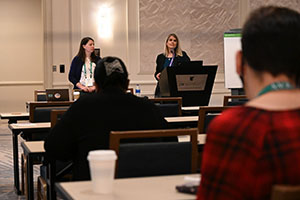
Written by Erin Mason, University Registrar, Ball State University
Live from AACRAO-SEM
Jeff Selingo, the keynote speaker for the AACRAO-SEM conference, equated the impact of the Covid-19 pandemic on higher education to the impact of the advent of the internet on journalism, encouraging higher education industry leaders not to fall victim to “hubris” and to adapt and respond to the needs of adult learners.
As an industry, the University model and associated deliverables have remained remarkably unchanged-- the concept of the degree as the successful completion of an academic course of study dates back to the thirteenth(!) century. And while the degree, for many learners, continues to be one key educational outcome, we know that grades and degree attainment are not the only outcomes of a particular program, nor is it the only goal for our learners. This gap in service is driving for alternative credentialing.
Kristi Wold-McCormick, of the University of Colorado Boulder, and Kelly Hoyland, of IMS Global, presented a session entitled “Microcredentials and Badges: Understanding and Implementing” to explore some of the work that is being done in higher education today. Badging and microcredentials have been around for years, but industry best practices are still being defined (look for AACRAO’s Microcredentials Working Group report in early summer 2022). However, some key terminology is generally accepted. To better understand the concepts, Wold-McCormick used a metaphor: the badge is to the microcredential as the diploma is to the degree. Microcredentials can range from informal (participation in specific professional development) to formal (recognition that a learner has achieved a specific skill or competency), and badges contain metadata that illustrate the requirements needed to attain the badge.
Presenters acknowledged that badges and microcredentials could be used to support many other initiatives. For example, badges may also be used to package curricular content in ways that encourage persistence. Hoyland stated that the research to date indicates that the attainment of badges may help learners see that they can be successful. For example, Wold-McCormick’s institution has packaged a few Masters-level programs into stackable badges that ultimately lead learners to matriculation into the degree program. Further, human resources and others may want to create badges representing faculty/staff learning (ex: completing a microcredential centered on equitable and just teaching or preparing staff with specific computer skills).
A few key considerations were shared to help you on your implementation journey: are your alternative credentials for degree and/or non-degree students? Will they be used for faculty/staff development? Will they be implemented in for-credit and/or non-credit/ continuing education? And will they be academic or co-curricular? How will these badges be created and awarded? Will we use a comprehensive learner record or badging system? Can this be wrapped into current digital credentialing initiatives? Presenters stressed that it is critical to develop a network of stakeholders who have vetted and fully understand (or help define) why your university wants to move forward with microcredentialing,
Wold-McCormick stated that you might already have programs at your University that have already designed, deployed, and assessed informal microcredentials programs that could be used to begin the efforts. For example, a department might be offering an off-the-books certificate (“little c” versus an officially-recognized academic Certificate) that could be considered for microcrendentialing. Or perhaps you’ve already had requests from your faculty and staff for increased credentialing capabilities. We learned that a great place to start is to begin a dialogue to determine interest, identify early adopters, and establish a working group to move the initiative forward. Developing a scalable structure, including defined standards and definitions, and creating an approval/review process to ensure your microcredentials are being vetted by key stakeholders is also essential. Hoyland said, “From the learner perspective, you will water down the value if they (the learners) don’t believe they’ve earned it.” Therefore, it is critical to understand why you are entering this realm and have laid the foundation needed to be successful.
Over the years, I have heard (and have possibly expressed) trepidation about moving into this field. However, the key considerations and takeaways from this session made it clear that to do this well; we must commit to creating the needed processes, policies, and procedures that ensure integrity and scalability and, let’s be honest, those are keys to the hearts and minds of registrars everywhere.
Interested in learning more about microcredentials and badging? Visit AACRAO's Alternative Credentials Workgroup page to explore the work currently being done.